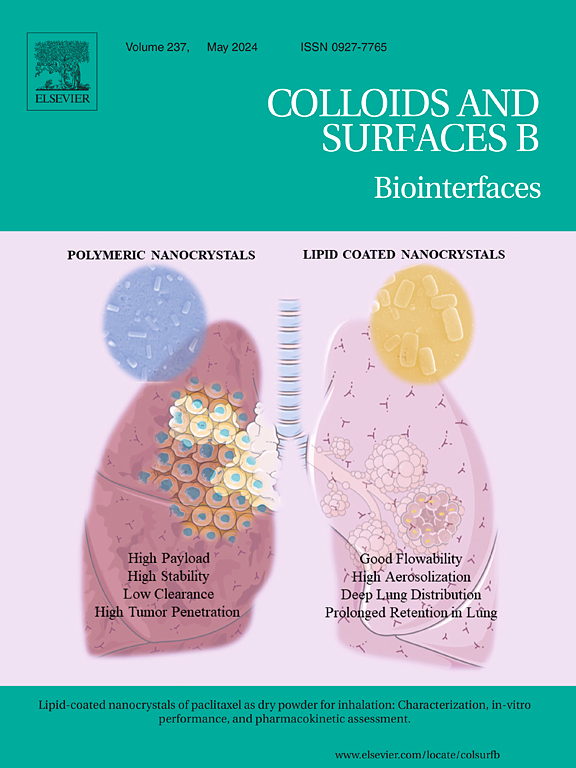Exploring glutathione-decorated micelles for drug delivery: A promise for enhanced cellular uptake
IF 5.4
2区 医学
Q1 BIOPHYSICS
引用次数: 0
Abstract
This study aimed to evaluate the effect of thiolated micelles on the cellular uptake of their payload.
Reduced and oxidized glutathione were covalently attached to palmitic acid via amide bond formation. Micelles formed with these thiolated surfactants (MP-GSH and MP-GSSG-P) were evaluated regarding critical micellar concentration (CMC) and hemolytic activity. Cytotoxicity was evaluated on HEK 293 and HeLa cells. Diffusion of micelles in these cells was evaluated by fluorescence correlation spectroscopy (FCS). Furthermore, cellular uptake of micelles containing coumarin-6 as model drug was analyzed by flow cytometry and confocal laser scanning microscopy.
CMC of MP-GSSG-P, MP-GSH, and palmitic acid micelles (MPA) was determined to be 0.455 mM, 0.166 mM, and 0.046 mM, respectively. At a concentration of 0.5 % MP-GSSG-P, MP-GSH, and MPA caused around 80 % hemolysis. In HEK cells, MP-GSSG-P exhibited toxicity at a concentration of 0.25 %, while MP-GSH showed toxicity at 0.06 % after 4 hours of incubation. In contrast, HeLa cells were more resilient, with only MP-GSH showing toxicity at 0.25 %. Diffusivity of MP-GSH and MP-GSSG-P within the cells was higher than that of MPA. Cellular uptake studies demonstrated a significantly (p < 0.05) enhanced internalization of MP-GSH and MP-GSSG-P, that was 112-fold and 270-fold higher in HEK 293 cells and 12-fold and 60-fold higher in HeLa cells when compared to MPA.
These findings suggest that MP-GSH and MP-GSSG-P could serve as promising vehicles for enhancing cellular uptake of drugs.
探索谷胱甘肽修饰胶束用于药物递送:增强细胞摄取的前景
本研究旨在评估硫代胶束对其有效载荷的细胞摄取的影响。还原和氧化谷胱甘肽通过酰胺键形成共价连接到棕榈酸上。这些巯基表面活性剂(MP-GSH和MP-GSSG-P)形成的胶束根据临界胶束浓度(CMC)和溶血活性进行了评估。对HEK 293和HeLa细胞进行细胞毒性评价。荧光相关光谱(FCS)评价了这些细胞中胶束的扩散。此外,通过流式细胞术和激光共聚焦扫描显微镜分析了香豆素-6胶束作为模型药物的细胞摄取。测定MP-GSSG-P、MP-GSH和棕榈酸胶束(MPA)的CMC分别为0.455 mM、0.166 mM和0.046 mM。浓度为0.5 %的MP-GSSG-P、MP-GSH和MPA引起约80% %的溶血。在HEK细胞中,MP-GSSG-P在浓度为0.25 %时表现出毒性,MP-GSH在4 小时后表现出0.06 %的毒性。相比之下,HeLa细胞更具弹性,只有MP-GSH表现出0.25 %的毒性。MP-GSH和MP-GSSG-P在细胞内的扩散率高于MPA。细胞摄取研究表明(p <; 0.05)显著增强了MP-GSH和MP-GSSG-P的内化,HEK 293细胞中MP-GSH和MP-GSSG-P的内化比MPA高112倍和270倍,HeLa细胞中MP-GSH和MP-GSSG-P的内化比MPA高12倍和60倍。这些发现表明,MP-GSH和MP-GSSG-P可以作为增强细胞对药物摄取的有希望的载体。
本文章由计算机程序翻译,如有差异,请以英文原文为准。
求助全文
约1分钟内获得全文
求助全文
来源期刊

Colloids and Surfaces B: Biointerfaces
生物-材料科学:生物材料
CiteScore
11.10
自引率
3.40%
发文量
730
审稿时长
42 days
期刊介绍:
Colloids and Surfaces B: Biointerfaces is an international journal devoted to fundamental and applied research on colloid and interfacial phenomena in relation to systems of biological origin, having particular relevance to the medical, pharmaceutical, biotechnological, food and cosmetic fields.
Submissions that: (1) deal solely with biological phenomena and do not describe the physico-chemical or colloid-chemical background and/or mechanism of the phenomena, and (2) deal solely with colloid/interfacial phenomena and do not have appropriate biological content or relevance, are outside the scope of the journal and will not be considered for publication.
The journal publishes regular research papers, reviews, short communications and invited perspective articles, called BioInterface Perspectives. The BioInterface Perspective provide researchers the opportunity to review their own work, as well as provide insight into the work of others that inspired and influenced the author. Regular articles should have a maximum total length of 6,000 words. In addition, a (combined) maximum of 8 normal-sized figures and/or tables is allowed (so for instance 3 tables and 5 figures). For multiple-panel figures each set of two panels equates to one figure. Short communications should not exceed half of the above. It is required to give on the article cover page a short statistical summary of the article listing the total number of words and tables/figures.
 求助内容:
求助内容: 应助结果提醒方式:
应助结果提醒方式:


